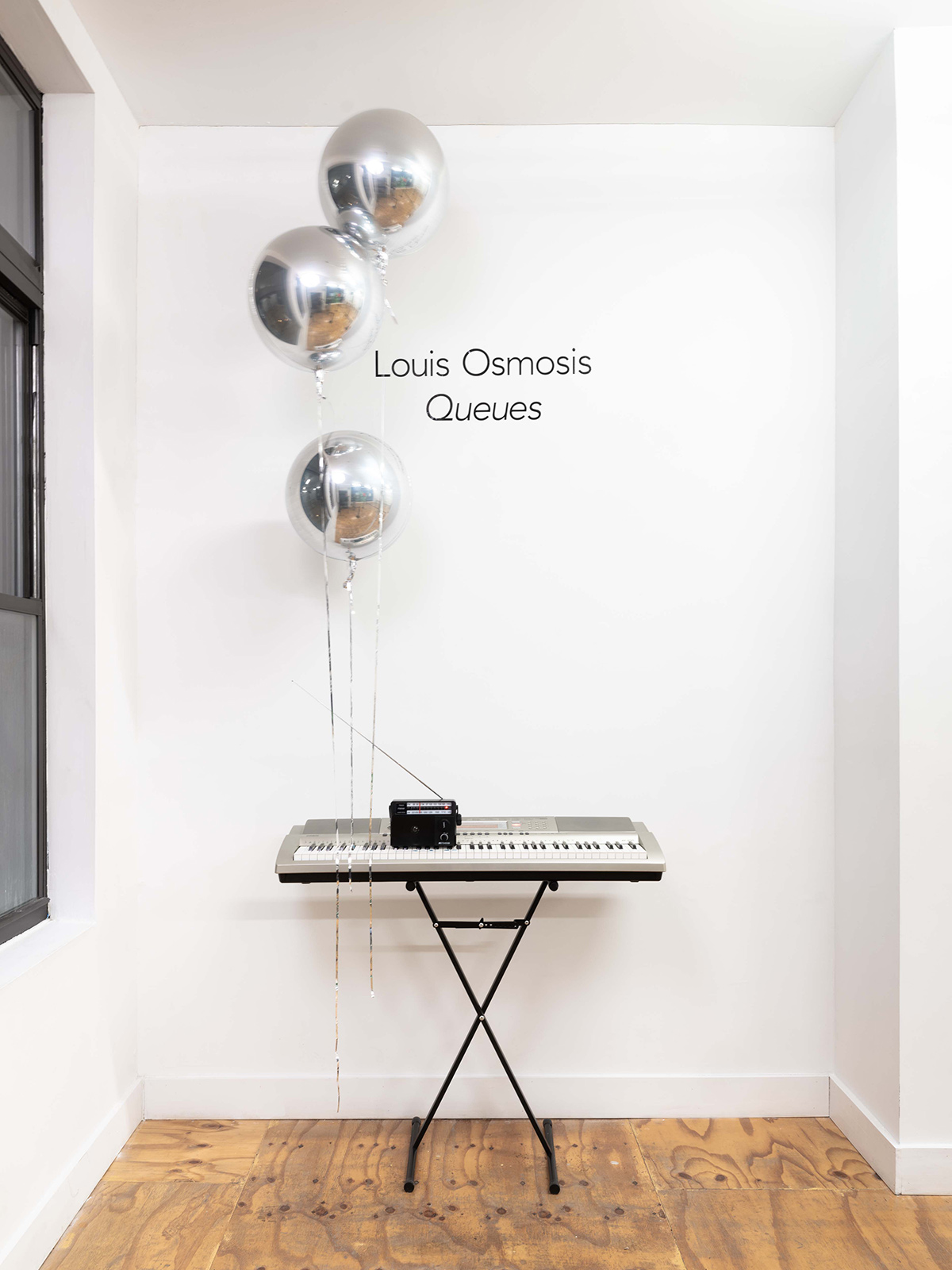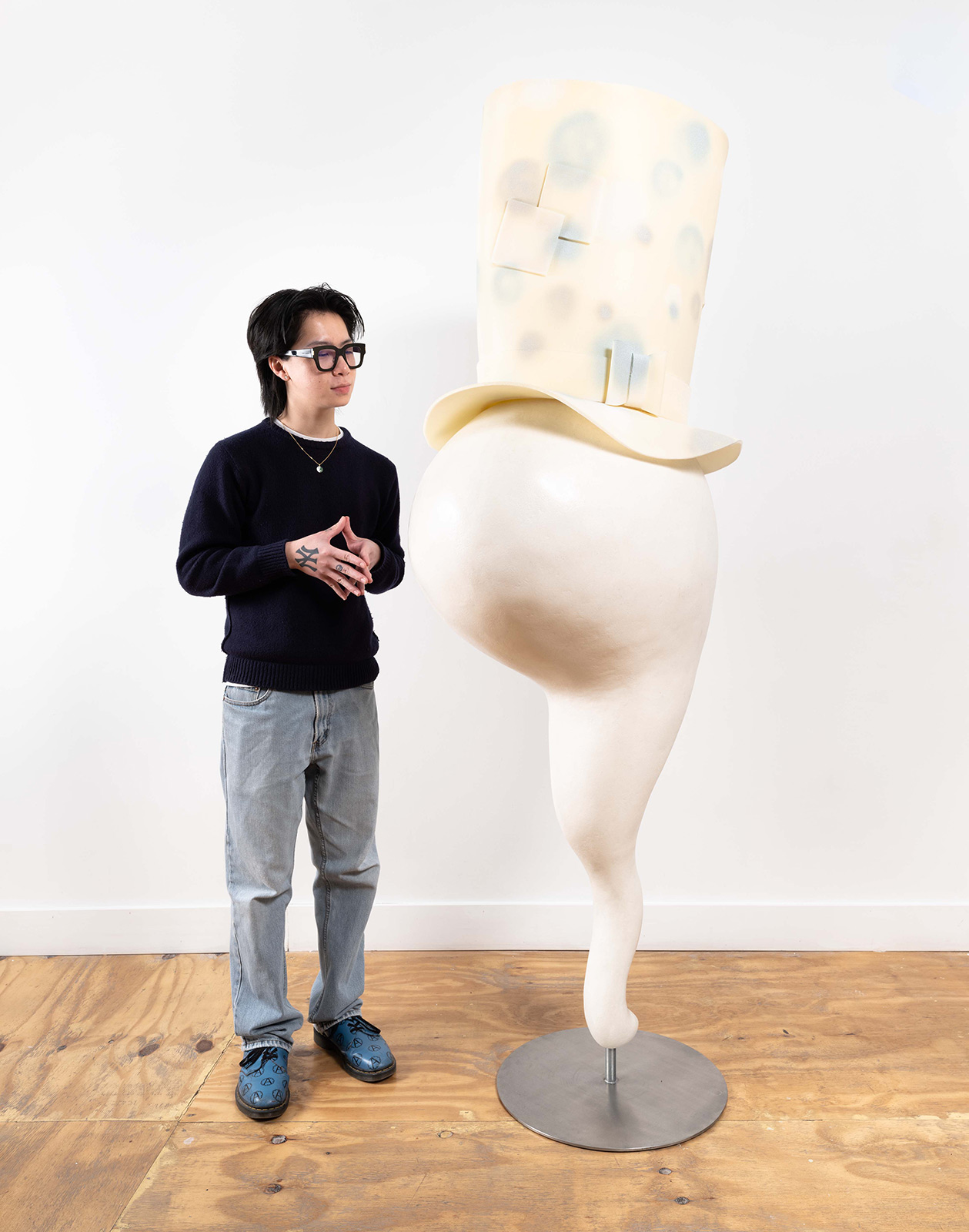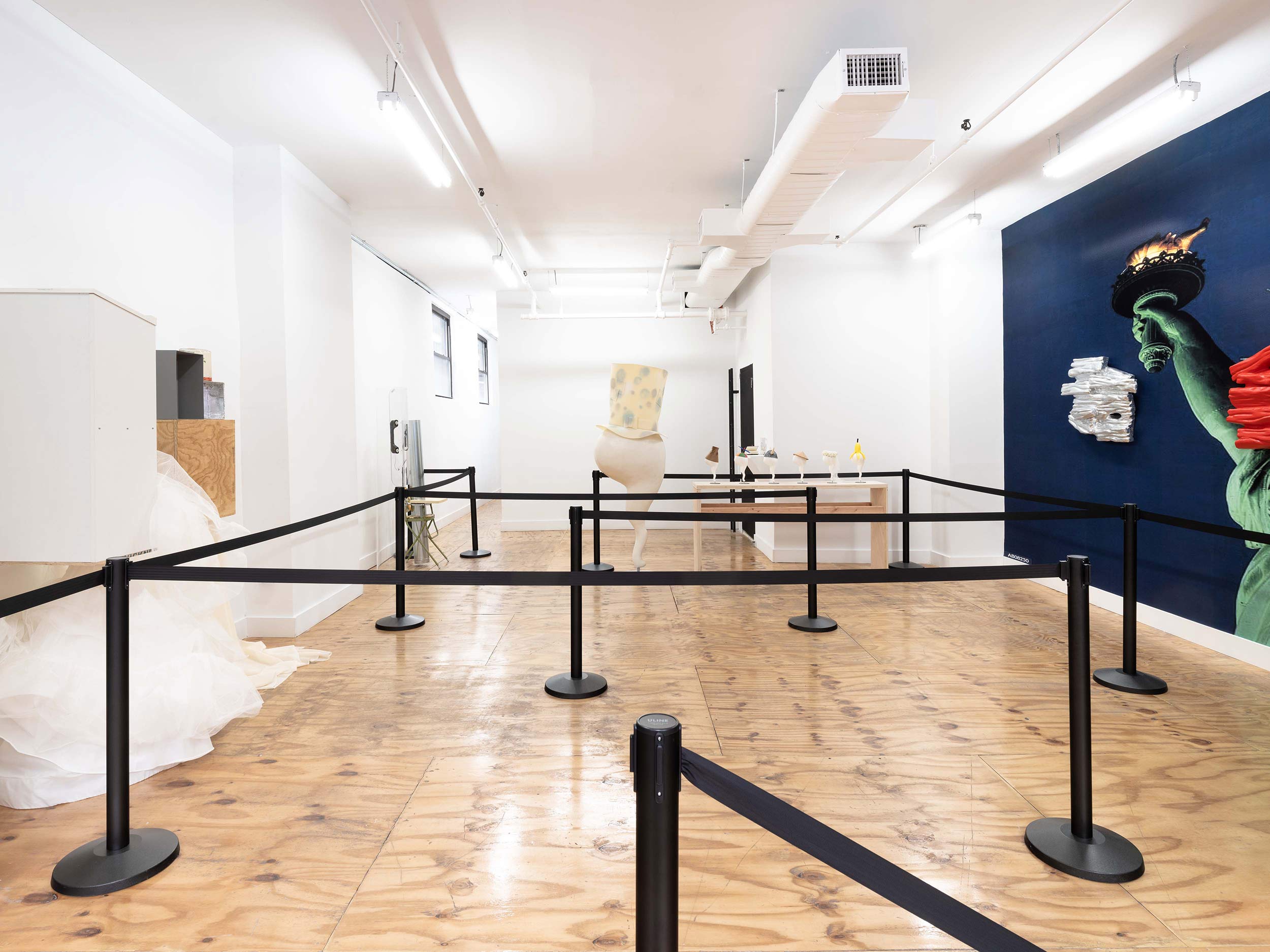
The sculptor’s most recent solo exhibition at Kapp Kapp gives the potency of ideas a spermatozoan mascot
THEN: Deadass, fucking, satellite
NOW: Allegations, giving, object
When you walk into an art gallery, you don’t expect to see a line, especially not one sectioned off by a maze of black stretchy stanchions. For sculptor Louis Osmosis, an airport is a gallery is a procession of NPCs fluent in the bureaucracy of waiting in line whether at the airport or outside the Supreme store. This Kafkaesque expression of biding time is the ideological undercurrent of his latest solo show Queues. On view at Kapp Kapp until March 9, Queues is, first and foremost, a means for Osmosis to serialize the feeling of an artistic epiphany, and situate it in a neat row.
For the South Brooklyn-born sculptor, lineage is literal. Osmosis’s heroes are a nearly seven-foot-tall papier-mâché cartoon sperm wearing a top hat named Big Mascot (Ragamuffin), placed at the beginning of the line, who acts like the conceptual mother to its six 15 inch-tall 3D printed plastic ducklings. Each wearing a different hat, the oversized male gametes are positioned in two wall-mounted dioramas, called Content House, for Los Angeles and Content House, for New York. Made of found plywood and draped fabric, the dioramas bring the shallow idea of a social media hypehouse into the art gallery, having a laugh at a new generation of artists who feel like any other clout-hungry “content creator.” On the gallery’s back wall, Osmosis has cut a hole into which he’s placed a two-way mirror, coated in resin, that peers into the storage room. When a vintage lamp automatically flips on, the reflective surface turns transparent, revealing Kapp Kapp’s closet filled with Osmosis’s retired pieces from former shows. Eureka! Old ideas don’t just watch the birth of new ones, they watch them fall in line.
Osmosis stands on business, 10 toes down for the progeny behind a concept, because after all, that’s how we all begin. His sculptures wield conceptual free range in their references to Richard Serra, Isa Genzken, Cady Noland, and the late Pope.L. In his arena, everyone’s on equal footing, the bespoke headwear of the Small Mascots analogous to the kind of individuation Queues deals with.
From epiphany to object, Osmosis has no problem using the word slippery to describe how he swims in his own ideas before talking about sperm as the building block of both life and this show’s conception. I forget to ask about the allegations he mentions he ate rather than beat, because it’d be much more interesting to don a cap and goggles to join him there.
Maya Kotomori: Is this hole in the wall a part of the show?
Louis Osmosis: Yeah, so this is [the gallery’s] storage room. The real first idea I had for the show were the stanchions, and then I thought Okay, if the stanchions are doing kind of a bad version of Serra where they spit you out somewhere else, I’d be remiss to not punctuate that with something equally stupid. Consider that they’ve done so much to hide the storage room—another missed opportunity to talk about. So I cut this hole in the wall, and there’s this two-way mirror in there that’s spritzed with resin to look like a rainstorm has passed. In the room is one of those weird Zen Buddhist lampshades that I found outside of a massage parlor, and my art from my last show. The lamp follows the logic of a thunderstorm, it flickers like [lightning] would, lighting up all the unsold work. The title for it is Incubator, because the stanchions spit you out right at this art object that is, on one hand, funerary because it punishes the objects that haven’t sold hiding in that room, but also is like a bad ICU for objects that are in limbo.
Maya: I’m imagining an early SVU situation where Stabler is just staring down a pedophile from the two-way mirror before storming into the interrogation room and turning the camera off…
Louis: No, facts. My whole reasoning for the two-way mirror thing was the I guess your subjectivity is implicated! moment, but that also incidentally generated this funny split audience thing. A lot of the fashion and fashion-adjacent girlies who came to the opening just assumed it’s a mirror, because sometimes it would be like 10 seconds before the light would flash, and they could see the whole thing.
Maya: Tell me about artistic reproduction, Louis.
Louis: The core of the show is artistic production insofar that it brings up the funny thing of models of inheritance. One inherits artistic traits in the same way that one inherits debt, or grief. That sets up a slippery paradigm that I can swim in a little bit. I don’t know what sparked my original dive into this particular thing, but I was rewatching a bunch of Mucinex and Nasonex commercials. The Mucinex mascot is a booger, and the Nasonex mascot is this Parisian flaneur of a bumblebee, right? I kind of had this epiphany, thinking about how it’s one thing to diagnose a model of inheritance [via] its progeny, but the real test is what flavor of entry do you take with that.
Maya: Like, ‘what will your mascot be?’ You made a cum one…
Louis: Ben and Jerry’s ‘Cum City.’ No for real, the epiphany with artistic inheritance is that the solution to decongestion is represented by the congestion, the booger. The solution to allergies and pollen is represented by the hyper-pollinator, the bumblebee. I realized the thing that affords [an object] its voice is the problem itself, like a problem can still loom over the whole dynamic, but also speak for both sides. So I was like, Bet, but if we’re really gonna get to the thing of progeny, and I’m really trying to indicate this inherent lack within it (no value judgment to the use of ‘lack’ here): What’s the best avatar for that, the one that can do the heavy lifting of speaking to its own formal history as an object, but also be its own means of producing poetics or content? And I was like, Oh, sperm. It’s the perfect thing, when you think of pedagogical images. I love that when people think of sperm they tend to think of a giant, really cute one, à la sex ed. And all it does is propagate.
“I was thinking of them as a funny nod toward the production of a rarified object, which is to say that rarity is anything if not just a hat, right? It’s like with Michelin star food: the one throughline is that it’s always garnished.”
Maya: They’re also competitive. They’re all fighting to fertilize, but only one will win. So there’s almost some value in being the one, at least how it’s narrativized in sex ed.
Louis: Yes. There’s this latency of individuation that’s in this thing that is literally faceless and, in this state, is like a clone of every single one that’s trying to do the same thing. To that point, I have Big Mascot (Ragamuffin) and all the little mascots, named Butterface, Co-Pilot, Weekend Warrior, Orient, Bridezilla, and Slippery Bastard. How it’s arranged has this mother duck-duckling thing that makes it read left to right like Big Mascot made the little ones. With the logic of the hats, I fabricated them to the point where they erase my hand a little bit. I was thinking of them as a funny nod toward the production of a rarified object, which is to say that rarity is anything if not just a hat, right? It’s like with Michelin star food: the one throughline is that it’s always garnished.
Maya: All the names of the little mascots have to do with the fact that they’re all the same, like it’s against the individual sperm cell story we were talking about, but also that they’re all typified by their hats.
Louis: I think Weekend Warrior really addresses that, because [people think] that the viking hat is either giving sportsman or giving renaissance fair. But the one commonality there that I would like to use to stomp out both of those allegations is that of the hobbyist. But then you get to Slippery Bastard, where the archetype of a ‘slippery bastard’ preceded itself, because there are no hats associated with that ‘type.’
Back to the stanchions: the last time I was at an international airport was when I was in Italy, for some reason the top three countries which experienced fascism have a strange relationship with a collective sense of laziness. [The] Germans are the only ones I think that were able to pin the logic of laziness on itself and call it lethargy. I’m walking through the lines of the airport and I think of kunst, meaning ‘art’ in German, and [when] people think of scatter art or found objects on a floor placed miles apart—it’s a genre. Then I’m hit with two things: one, everyone between age five to old-as-dirt is profoundly literate in how to operate in these kinds of spaces, and that it would seem like we’re preconditioned to the logic of bureaucracy. Specifically, the architecture of the queue shifts, and the choreography also shifts at a turning point: you’ll see an assemblage of, like, ivory tusks made of plastic, or a Supreme Louis Vuitton bag, or the hollow shell of an elephant foot, all objects that have been hyped or fabricated to signify that you’re not supposed to have them. It speaks of the efficacy of pop to afford itself this unassumed nature, but also this hyperrealist mode of manufacture. This is the poetics of contraband; it just needs a queue.
Maya: I remember you were wearing contacts printed with the American flag at the opening. What’s this wall sculpture mean when considering that choice?
Louis: Essentially, a prompt I gave myself was: How do I make an NPC wall sculpture hypersexy? The thing I landed on was the finish for these three pieces. They’re papier-mâche, but I have them fabricated to the point where the patina kind of gives [it] a different [place], almost. Specifically, the animatronic sculptures you’ll see at Chuck E. Cheese or like Dave & Busters were the finish I was going for. The flag thing… I really think Cady Noland is pertinent here. She uses signals of America insofar that there is an understated idea of scale present in her work, and she’s also really good at fucking with that sense of scale. Hence why this piece exists in the American flag-colored context; that’s my use of scale.
Maya: Why scale the Statue of Liberty to the point of pixelation?
Louis: A key reference point in terms of methodology here is Isa Genzken, specifically her mannequin pieces. I realize the reason the mannequin pieces I made in my Amanita show work is—and my homegirl Olivia uses this phrase in the press release for this show—an ‘avalanching of interior logic.’ Before a mannequin is a placeholder for a would-be consumer or subject, it is a display apparatus for clothes. [Genzken’s] means of making form with that series is to overperform the mannequin, to go hypermannequin. With this big-ass wall, I wanted to use that same model of redundancy. So I just thought, Imma use a big, free image of freedom.
Maya: Freedom is free.
Louis: No, exactly. When we got this Getty Image printed, we told the people, like ‘Listen, fidelity is not the issue.’ If anything, I’m an infidel. We just gave them the exact dimensions of the wall and whatever we get, we get. I’m gonna take my liberty with Lady Liberty. Let me stretch Liberty, and see how far it goes.
Maya: See, I had assumed you had made your own Getty credit, and doctored the photo to look like it was from Getty Images.
Louis: You know, we went so far to see if we could invite the guy who took the photo to the opening, but he died. Nameless hero. To the video game logic of an NPC: it might be used as a derogatory term, but NPCs are the only characters who can go beyond the game map. They don’t have limits.












